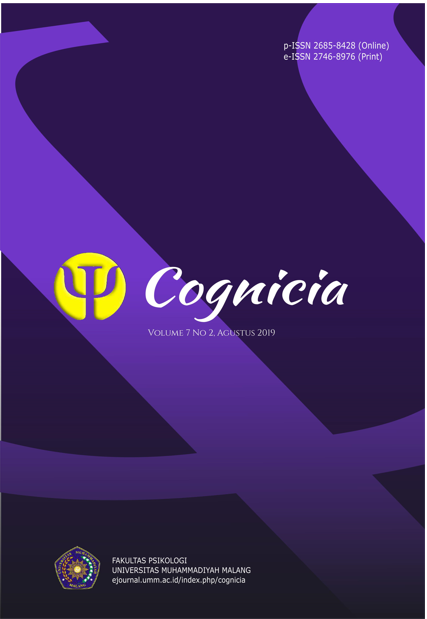Penguatan positif sebagai upaya menumbuhkan perilaku disiplin pada siswa sekolah dasar
DOI:
https://doi.org/10.22219/cognicia.v7i2.9238Abstract
Discipline can be defined as an indication of one’s behavior, that occurs in a regulations of an institute, either written or unwritten. An individual with a self-discipline behavior is likely to obey the rules and regulation and is easier ro be ruled than those who don’t. There are two ways to get self-discipline for students. Punishment or positive reinforcement. However, positive reinforcement is more reliable because it will give stronger effect to change one’s behavior. This research is using a Single Case kind of research with a Quasi Experiment design. This experiment uses guide observations and interviews. The subject in the experiment is a couple of male students who don’t have self-discipline. To determine the subject is to use Purposive Sampling. The result of the research is that there is a behaviour change from not having a self-discipline to having a self-discipline after given a treatment. This shows that Positive reinforcement has better effect towards student’s self-discipline.
Downloads
References
Ahmed, M., & Gill, B. R. (2015). Use of Motivational Expressions As Positive Reinforcement in Learning English At Primary Level in Rural Areas of Pakistan. International Journal of English Teaching, 3(1), 32–47. Alwisol, M. (2009). Psikologi kepribadian (Ed. revisi). Malang: UMM Press. Arikunto, Suharsimi. (2006). Metodologi penelitian. Yogyakarta: Bina Aksara. Aqib, Z. (2011). Pendidikan karakter: Membangun perilaku positif anak bangsa. Yrama Widya. Chaplin, J. P. (2011). Kamus lengkap psikologi. Jakarta: PT. Raja Grafindo Persada. Cote, D. L., & Sparks, S. L. (2016). Positive behavior supports in middle and secondary school. Autism spectrum disorders: Identification, education, and treatment, 312. Dolet, U. (2003). Manajemen disiplin. Jakarta: Grasindo. Fallon, L. M., McCarthy, S. R., & Sanetti, L. M. H. (2014). School-wide positive behavior support (SWPBS) in the classroom: Assessing perceived challenges to consistent implementation in Connecticut schools. Education and Treatment of Children, 37(1), 1–24. Hamid, D. (2009). Kemampuan dasar mengajar. Bandung. Alfabeta. Hox, J. J., Moerbeek, M., & Van de Schoot, R. (2017). Multilevel analysis: Techniques and applications. Routledge. Hulac, D., Benson, N., Nesmith, M. C., & Wollersheim Shervey, S. (2016). Using variable interval reinforcement schedules to support students in the classroom: An introduction with illustrative examples. Journal of Educational Research and Practice, 6(1), 6. Irham, M., & Wiyani, N. A. (2013). Psikologi Pendidikan: Teori dan Aplikasi dalam proses pembelajaran. Yogyakarta: Ar-Ruzz Media. Ladouceur, C. D., Schlund, M. W., & Segreti, A.-M. (2018). Positive reinforcement modulates fronto-limbic systems subserving emotional interference in adolescents. Behavioural Brain Research, 338, 109–117. Lassen, S. R., Steele, M. M., & Sailor, W. (2006). The relationship of school-wide positive behavior support to academic achievement in AN Urban middle school. Psychology in the Schools, 43(6), 701–712. https://doi.org/10.1002/pits.20177 Maag, J. W. (2001). EBSCOhost: Rewarded by punishment: Reflections on the disuse of positive reinforcement. 67(2). Retrieved from http://web.ebscohost.com.proxy.lib.utk.edu:90/ehost/pdfviewer/pdfviewer?sid=48d479cf-1f84-4a49-ad6a-0f3d55782d85%40sessionmgr113&vid=4&hid=124 Majid, A. (2012). Perencanaan pembelajaran. Bandung: PT. Remaja Rosdakarya). Morin, Danielle, "The effects of inclusion and positive reinforcement within the classroom" (2017). Honors Program Contracts. 4 from htp://scholarworks.merrimack.edu/honors_component/4 Mulder, R. (n.d.). 1.2 Reducing Students’ Littering Behaviour by Application of Persuasive Techniques. Published 2016, 17. Nitisemito, A. S. (1982). Manajemen personalia (Manajemen sumber daya manusia). Ghalia Indonesia. Prijodarminto, S. (1994). Disiplin kiat menuju sukses. Cetakan keempat. Jakarta: PT Abadi. Putri, A.W. (2018, March 29). Menimbang efektivitas hukuman pada anak. Retrieved February 20, 2019, from https://tirto.id/menimbang-efektivitas-hukuman-pada-anak-cGBu Rumfola, L. (2017). Positive reinforcement positively helps students in the classroom. Retrieved from http://digitalcommons.brockport.edu/ehd_theses/786 Sarlito, W. S. (1978). Berkenalan dengan aliran-aliran dan tokoh-tokoh psikologi. Jakarta. PT Bulan Bintang. Santrock, J. W. (2011). Perkembangan anak. Terjemahan: Sarah G. B) Jakarta: Erlangga. Smith, T. W. (1983). An experimental comparison of clustered and scattered scale items. Social Psychology Quarterly, 46(2), 163-168. Soemanto, W. (1998). Psikologi pendidikan. Bandung: Rineka Cipta. Sugiyono, W. E. (2001). Statistika penelitian dan aplikasinya dengan SPSS 10.0 for Windows. Bandung: Alfabeta. Sutikno, S. (2010). Pengelolaan pendidikan tinjauan umum dan konsep islami. Bandung: Prospect. Thorndike, E. L. (1927). The law of effect. The American Journal of Psychology, 39(1/4), 212–222. Tulus, T. (2004). Peran dan disiplin pada perilaku dan prestasi siswa. Jakarta: Grasindo. Yasmin (2009, March 9 th). Cara asyik ajari anak disiplin tanpa drama. Retrieved March 10, 2019, from https://www.liputan6.com/health/read/3907687/7-cara-asyik-ajari-anak-disiplin-tanpa-drama?related=dable&utm_expid=.9Z4i5ypGQeGiS7w9arwTvQ.1&utm_referrer=https%3A%2F%2Fwww.google.com%2F Zubaedi, D. P. K. (2011). Konsepsi dan aplikasinya dalam lembaga pendidikan. Jakarta: Kencana.
Downloads
Published
How to Cite
Issue
Section
License
Copyright (c) 2019 Yussidah Azmiyatul Haqq

This work is licensed under a Creative Commons Attribution-ShareAlike 4.0 International License.
Authors who publish with Jurnal Cognicia agree to the following terms:
- For all articles published in Jurnal Cognicia, copyright is retained by the authors. Authors give permission to the publisher to announce the work with conditions. When the manuscript is accepted for publication, the authors agree to automatic transfer of the publishing right to the publisher.
- Authors retain copyright and grant the journal right of first publication with the work simultaneously licensed under a Creative Commons Attribution-ShareAlike 4.0 International License that allows others to share the work with an acknowledgment of the work's authorship and initial publication in this journal.
- Authors are able to enter into separate, additional contractual arrangements for the non-exclusive distribution of the journal's published version of the work (e.g., post it to an institutional repository or publish it in a book), with an acknowledgment of its initial publication in this journal.
- Authors are permitted and encouraged to post their work online (e.g., in institutional repositories or on their website) prior to and during the submission process, as it can lead to productive exchanges, as well as earlier and greater citation of published wor (See The Effect of Open Access).

This work is licensed under a Creative Commons Attribution-ShareAlike 4.0 International License







